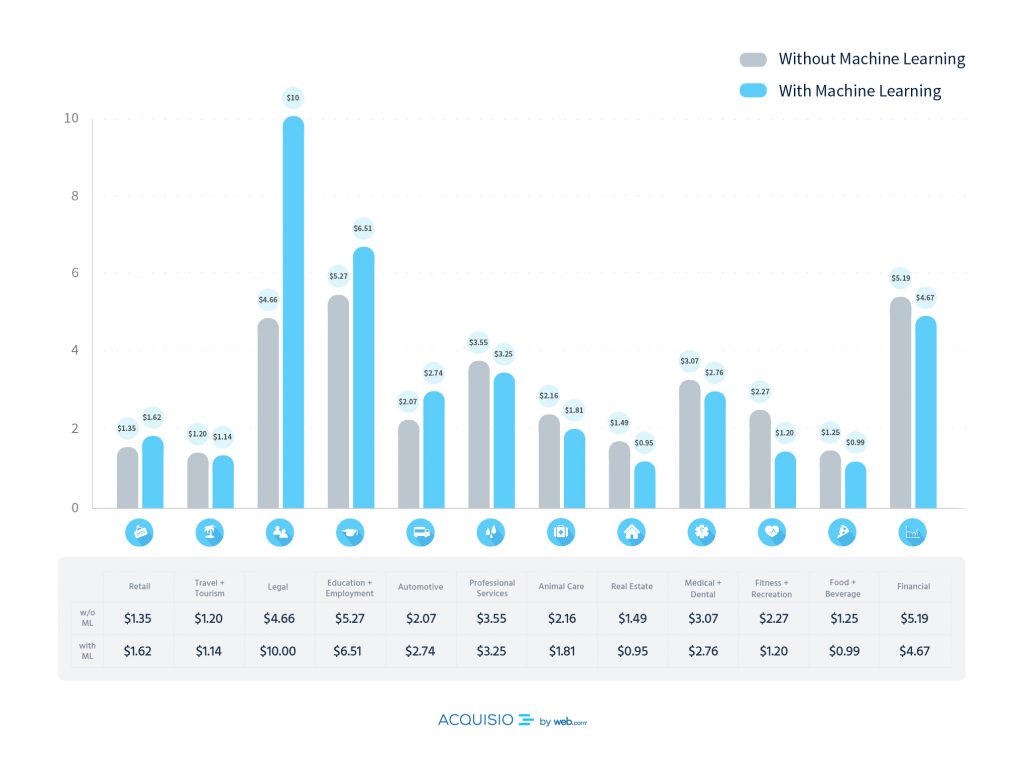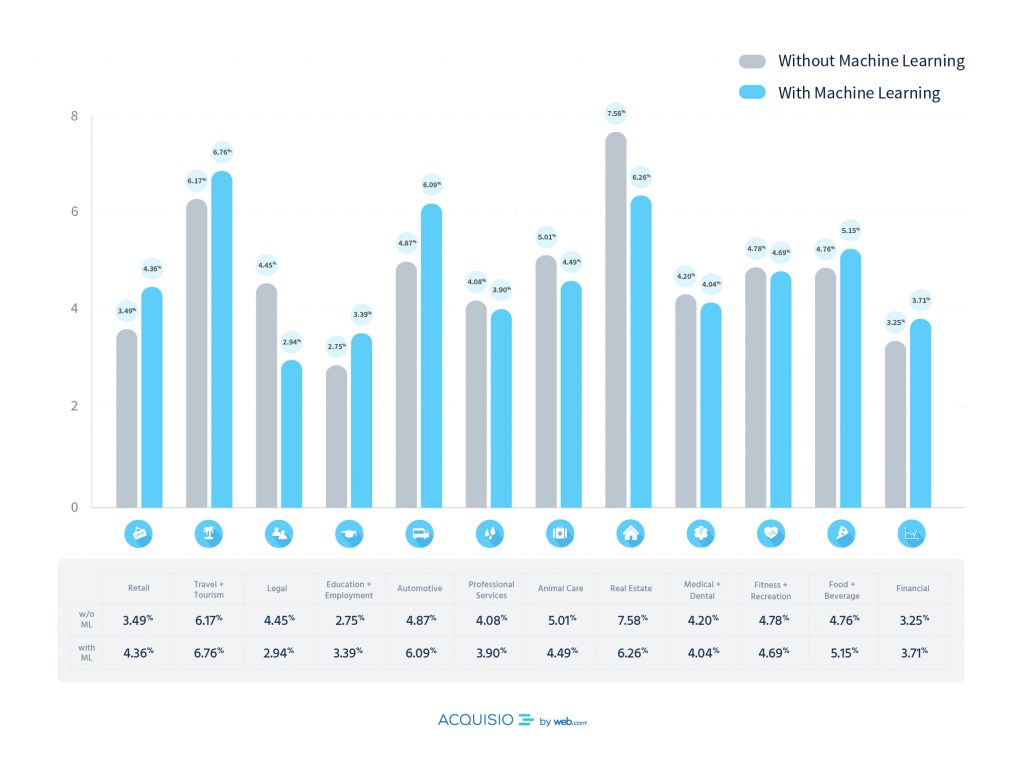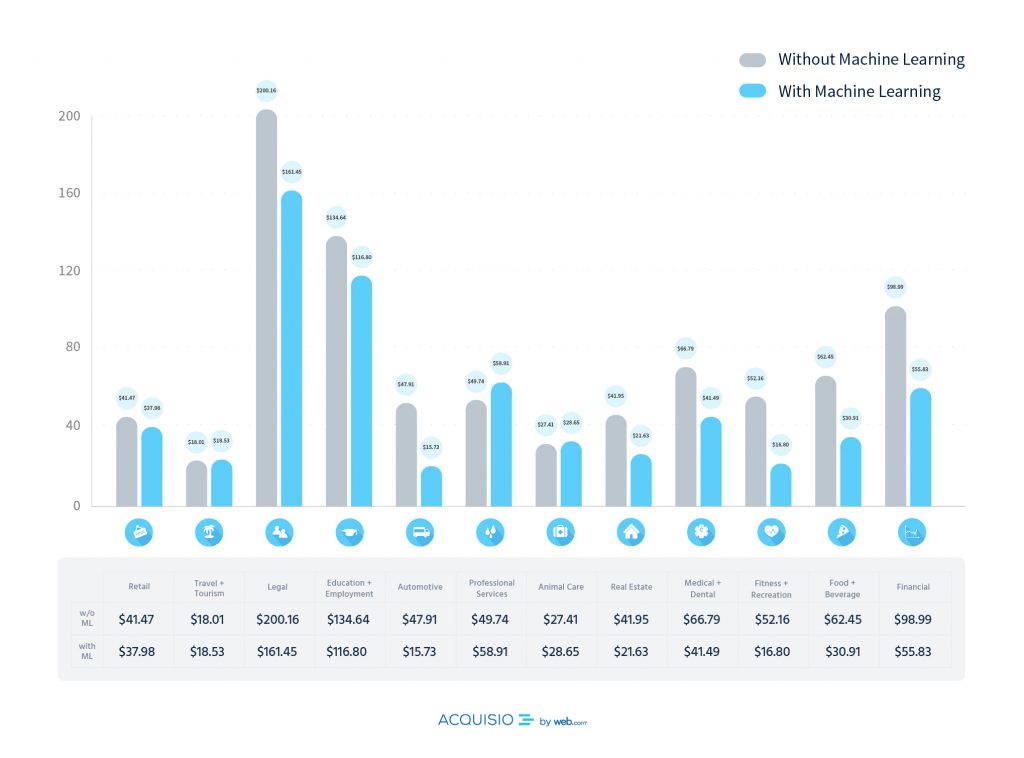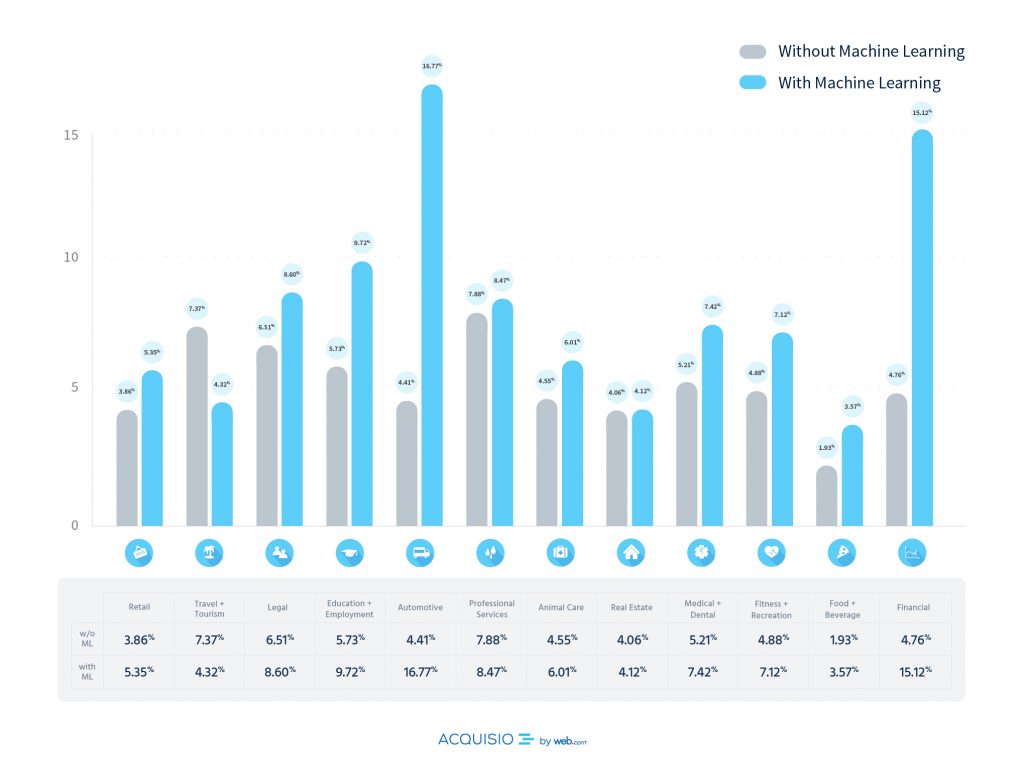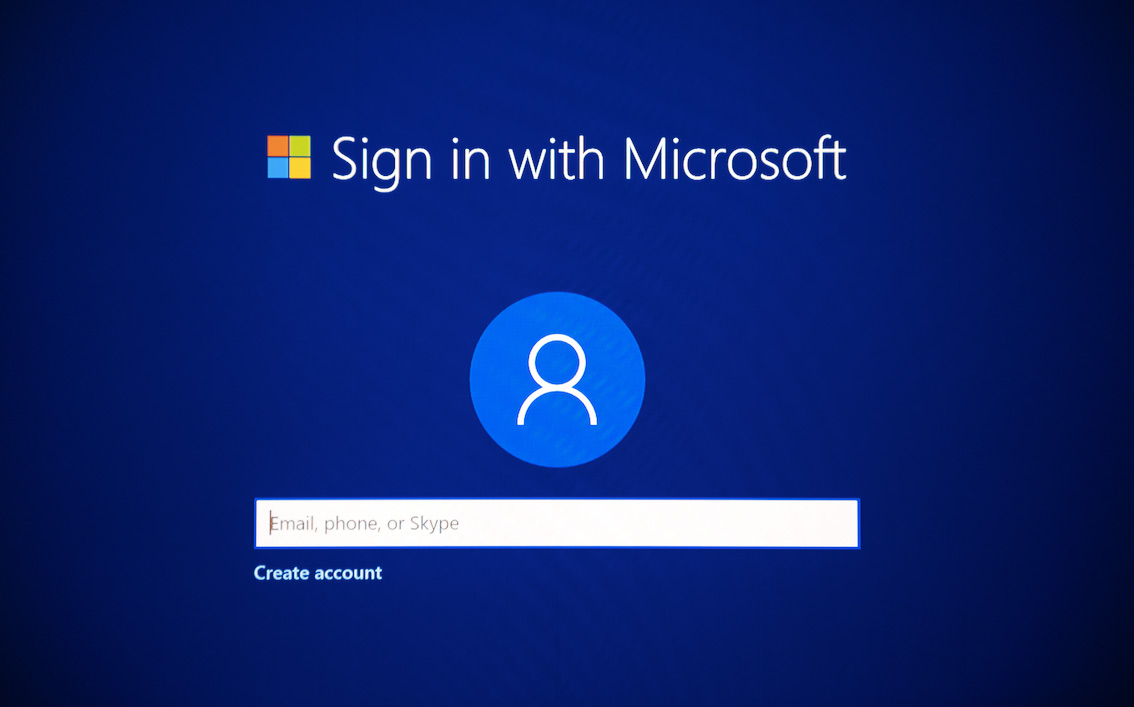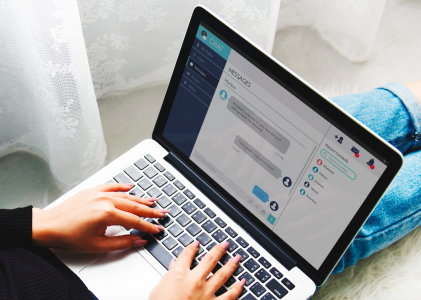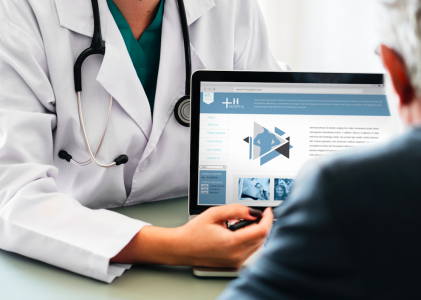On average 1300 people worldwide ask Google “What is a good CTR?” every month. Google AdWords industry benchmarks aren’t regularly released by Google, so other thought leaders and platforms have aggregated their data to bring PPC benchmarks to life.
Knowing if key performance indicators (KPIs) are up to par allows agencies and advertisers to understand their success relative to their competitors. It would be great to have eyes on how our competition’s ad campaigns perform across the board, but in the absence of this data, benchmarks provide a broad-picture indicator of industry success and are useful for performance measurement.
New levels of success have been made possible in PPC thanks to machine learning. Machine learning can improve key metrics by reducing CPC and CPA while increasing CTR and CVR…sounds pretty good right? By how much though? What can campaign managers expect? Here we uncover industry-specific AdWords benchmarks for common search KPIs with and without machine learning.
These benchmarks were created based on 50,000 campaigns, created by 11,000 advertiser accounts inside the Acquisio platform from the United States, Australia and Canada in Q3 2017. The total ad spend across all campaigns was $124,285,412. The following 12 industries were included in this analysis:
- Retail
- Travel & Tourism
- Legal
- Education & Employment
- Automotive
- Professional Services (Contractors, Plumbers, Hair, Nail, Electricians etc.)
- Animal Care
- Real Estate
- Medical & Dental
- Fitness & Recreation
- Food & Beverage
- Financial
Within each industry we established a benchmark cost per click (CPC), cost per acquisition (CPA), click through rate (CTR) and conversion rate (CVR) with and without the application of machine learning optimization. Machine learning algorithms turn limitations into strengths. Things like low budgets, lack of optimization expertise, limited data and time are no longer a problem. Machine learning optimization algorithms used in this study adjust bids and budgets to achieve optimal performance.
Cost Per Click (CPC)
“CPC measures exactly how much an advertiser has paid. You can measure CPC by dividing the total cost of a campaign by the number of times the ad was clicked in that campaign.”
-Chandal on Search Engine Journal
The cost per click benchmarks tell a few interesting stories. Right off the bat it’s obvious how much these CPC benchmarks vary per industry. The financial industry pays over $5 per click, while the food and beverage industry (including restaurants and coffee shops) is paying just over a dollar.
The Education and Employment sector has the highest median CPC of all the industries at $5.27. The Travel and Tourism sector had the lowest median CPC at $1.20. Machine learning had the biggest impact on the Fitness and Recreation sector, reducing CPC by 47%.
While campaign managers may think that they should always strive for the lowest CPC, that’s not necessarily the best strategy. Sometimes it’s necessary to bid higher to get more clicks and/or conversions. Therefore, if you’re paying more than these industry CPC benchmarks, don’t get down on yourself because your overall campaign performance may be better as a result – CPC is just one piece of the puzzle.
Click Through Rate (CTR)
“CTR is measured by dividing the total number of clicks your campaign got in the month (or period being reported) by its total impressions. This equation tells you that out of say 1,000 impressions, your ad was clicked 100 times and your CTR is 10 percent for example.”
– Chandal on Search Engine Journal
PPC Hero’s Matt Umbro has a wealth of experience and wrote in May last year that 2% is a good CTR, but still marketers should keep trying to get better results. Similarly, WordStream’s benchmark report from Q2 2015 found that 1.92% CTR was the average across all industries. So in general, PPC and SEM marketers can start there at around 2%. But the higher the CTR, the better. Better CTRs means better quality score and overall campaign performance.
The benchmark CTRs presented above again demonstrate the sheer variance by industry. CTR by industry is complicated by the fact that each is limited to the availability of impressions. Meaning there are only so many people in the world interested in your products or services available to click on ads in a particular month. Therefore, higher CTRs in a particular industry can be due to lower available impressions, such as the real estate industry where location can limit the amount of available inventory.
The Real Estate sector had the highest CTR at 7.58%. Travel and Tourism had good results as well at 6.17%. The Education and Employment sector had the lowest CTR at 2.75%. Machine learning had the biggest impact on the Automotive and Retail sectors, increasing CTR by 25%.
Cost Per Acquisition (CPA)
“Google defines the average CPA as the price advertisers pay for every new customer they acquire, which is calculated by dividing the total cost of conversions by the number of conversions. Google determines the CPA based [indirectly] on your quality score.”
-Chandal on Search Engine Journal
Marketers want to maximize the amount of clicks that convert for their budget. And of course, looking at the value of acquiring a new customer is pivotal here. Lawyers might be paying 200$ for a lead, but if that click converts they will make thousands off of that client. Similarly, restaurants are paying a lot to acquire new customers with a CPA of $62.45 but this is offset by the fact that impressed customers will likely return and have a lifetime customer value.
The Legal sector has the highest cost per acquisition at $200.16. The Travel and Tourism sector has the lowest cost per acquisition at $18.01. Machine learning had the biggest impact on the Fitness and Recreation sector, reducing CPA by 68%, and Automotive, reducing CPA by 67%.
Conversion Rate (CVR)
“You can measure conversion rate in AdWords by dividing the number of conversions the campaign received by the total clicks. Since conversion rate is expressed as a percentage, if the campaign had 100 clicks and 10 conversions, 10/100 means that the conversion rate would be 10 percent.”
-Chandal on Search Engine Journal
Conversions can be anything that the advertiser sets as a conversion goal, including sales, newsletter signups, volunteers and more. The CVR benchmarks tell us how well marketers are converting their paid traffic into their desired goal.
The Professional Services sector has the highest conversion rate of all industries at 7.88%, followed closely by the Travel and Tourism sector at 7.37%. The Food and Beverage sector had the lowest conversion rate at 1.93%. Machine learning had the biggest impact on the Automotive sector, increasing CVR by 280%, and the Financial sector, increasing CVR by 218%.
Conversion rate is dependant on the landing page and conversion pathway set out by the PPC marketer. To improve conversion rates, look at the entire campaign journey and apply some conversion optimization science and A/B test the hell out of your landing pages until they’re perfect.
More Industry Level Insights Around Machine Learning’s Impact on PPC Performance
The Financial Industry
The financial industry includes banking, financing, insurance, accounting, asset management and more. In the benchmarks above we see that in the financial industry, when machine learning is applied CPC goes down, CTR goes up, CPA goes down and CVR goes up. This is the ideal scenario, making the financial industry the perfect candidate for machine learning optimization.
The Food and Beverage Industry
The Food and Beverage Industry in our case is composed of restaurants, caterers, bakeries, breweries, coffee shops and more. In the benchmarks above we see another ideal scenario playing out. With machine learning CPC goes down and CPA is literally cut in half. Simultaneously CTR and CVR increase. Food and Beverage is also winning with machine learning optimization for bids and budgets.
The Medical and Dental Industry
The Medical and Dental Industry is composed of a wide range of health professionals including doctors, cardiologists, allergists, pharmacies, nursing homes, cosmetic surgeons, dentists, orthodontists and more. The benchmarks above show that while CPC goes down with machine learning and medical and dental professionals are paying less, the CTR also goes down. This relationship occurs because the machine learning algorithms are looking at every possible auction in which to bid, so impressions go up while the CTR goes down. Overall though, the CPC and CPA will go down while CVR goes up because machine learning is placing better bids and converting traffic.
The Fitness and Recreation Industry
The Fitness and Recreation Industry is made up of fitness centers, personal trainers, dance studios, day spas, yoga studios, skydiving centers and more. The benchmarks above tell a similar story for this industry as it did for the Medical and Dental Industry, but it’s a little more dramatic. Machine learning had the biggest impact on this industry significantly lowering CPC and CPA costs, more so than any other industry. The CPA drops from $52.16 to $16.80, but even with less clicks the CVR still went up.
The Automotive Industry
The Automotive Industry is made up of car dealers, auto and body repair shops, car rental companies, trailer sales, motor oil services, restoration shops and more. Looking at the data above, the CPC increases for the Automotive Industry when machine learning is applied. This happens because the machine will give a higher bid in order to yield better placement and subsequent conversion or better performance for clicks.
Even with higher costs, the benchmarks show click through rate increasing when machine learning is applied. In this case the machine is getting more volume or clicks and spending as much of the budget as possible, while the CPA goes down and conversions increased by 280%! This industry most definitely benefits from machine learning. Also note that this industry has a ton of inventory to manage, so letting the machine bulk manage those campaigns saves a ton of time for campaign managers.
The Retail Industry
The Retail Industry includes almost every kind of retailer like carpet stores, baby stores, electronics stores, jewelry stores, candy stores, shoe stores and much more. For retailers, the benchmark story is also ideal when machine learning is applied. CPC goes up but CTR also goes up because the bids are better placed and getting more clicks for the same budget. CPA goes down though, saving retail advertisers money, while conversion rates go up, making them more money.
The Professional Services Industry
The Professional Services Industry is also quite diverse, comprised of general contractors and home repair, landscapers, electricians, cleaning services, hair salons, moving companies and much more. Interestingly, with the benchmark data above we see that the Professional Services industry has the best conversion rates even without machine learning applied, giving them an advantage. However, marketers serving this industry should be relieved that when machine learning is applied the CVR continues to improve!
PPC Benchmarks and YOU
Data can lack details. While as marketers we need to make decisions backed by data, an average or median KPI benchmark value doesn’t give a complete picture, no matter how big the sample size. This is for one main reason – ad quality. The benchmark data provided doesn’t give any information about the quality of the ads, including campaign structure, targeting, copy, keywords etc. This isn’t to say that benchmarks are not highly valuable data points to compare performance, rather it is to say that if your performance isn’t up to these numbers or CTRs seem low for example, use them as a reference but draw your own conclusions from your own campaign data. You may have better ad performance than another person in the same industry because you created higher quality ads.
High costs can yield high returns. Median CPCs and CPAs are much higher in certain industries than others. While there are many factors contributing to this reality, advertisers have to look at their end game – returns! If the return on one conversion from PPC is high, it may be worth allocating marketing spend in this channel, even though initial investments are steep.
Some industries are perfect for machine learning and PPC campaigns. There are so many factors that can affect performance in search campaigns, but even so some industries really shine no matter what.
Remember that your situation is unique and you may experience different results than the benchmarks presented in the study. It’s important to investigate if you are too far off though. Measure, test, iterate, find tools to enable your optimization and never stop improving campaigns.
Complete Google AdWords Industry Benchmarks Infographic
Test drive Acquisio and see why hundreds of agencies worldwide have trusted Acquisio’s award-winning and renowned technology for more than a decade. Get a free demo today!
Image Credits
Feature Image: Unsplash/Justyn Warner
All screenshots taken by Chandal Nolasco da Silva.
Image 1-4: Screenshots from Acquisio by Web.com

